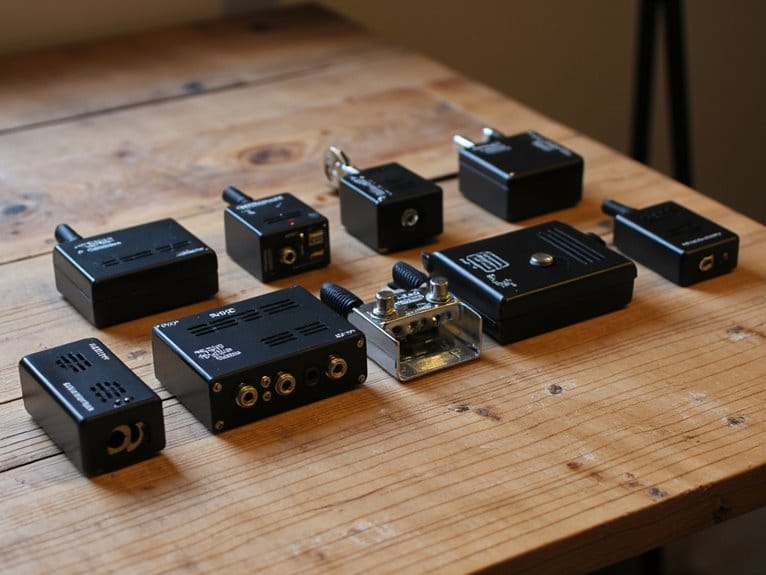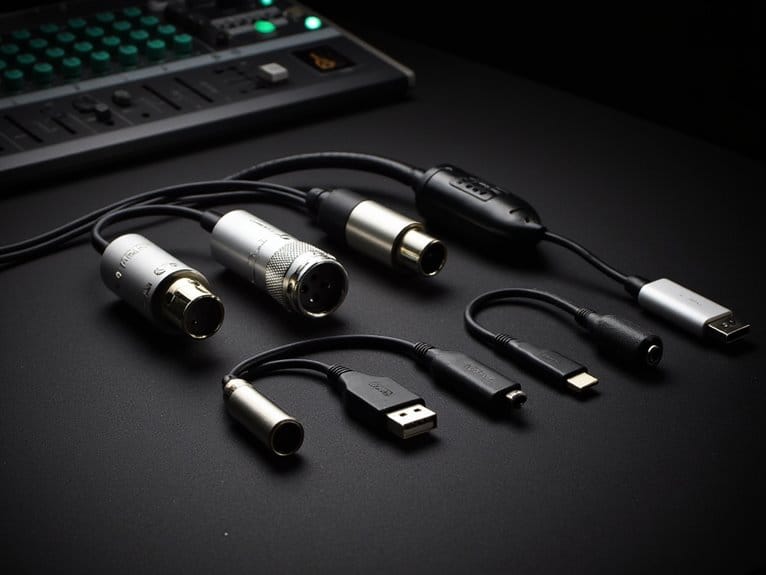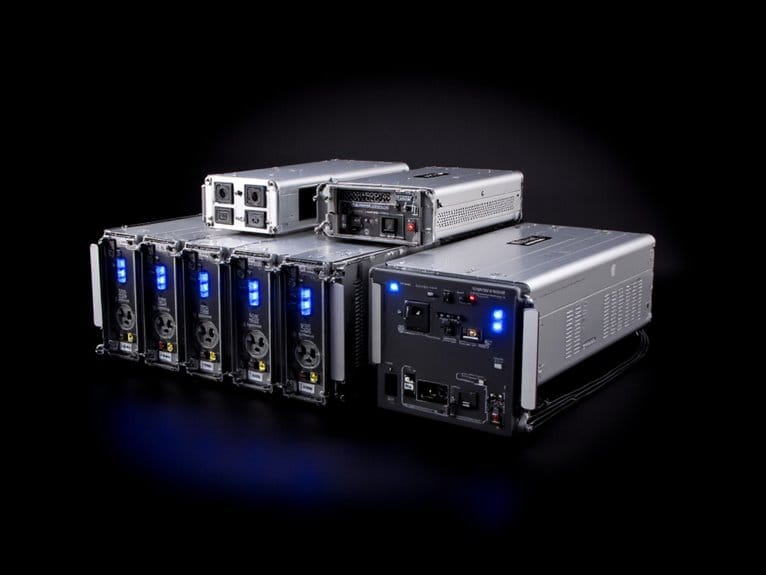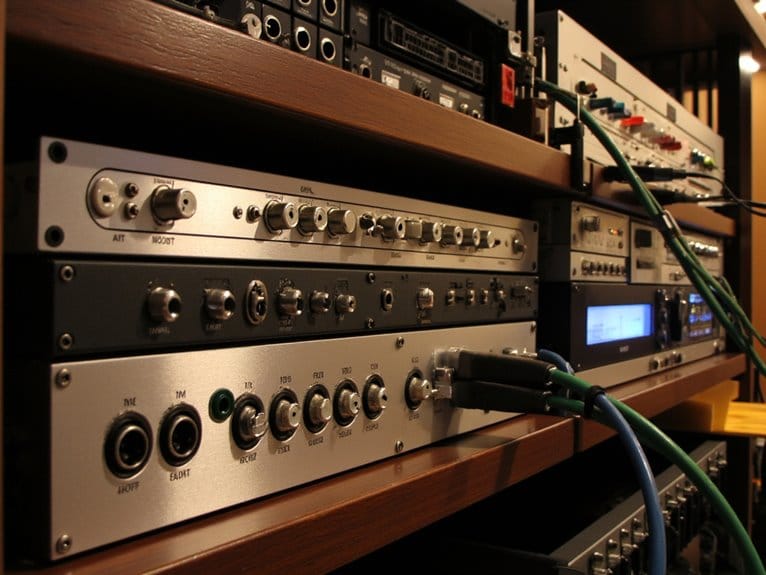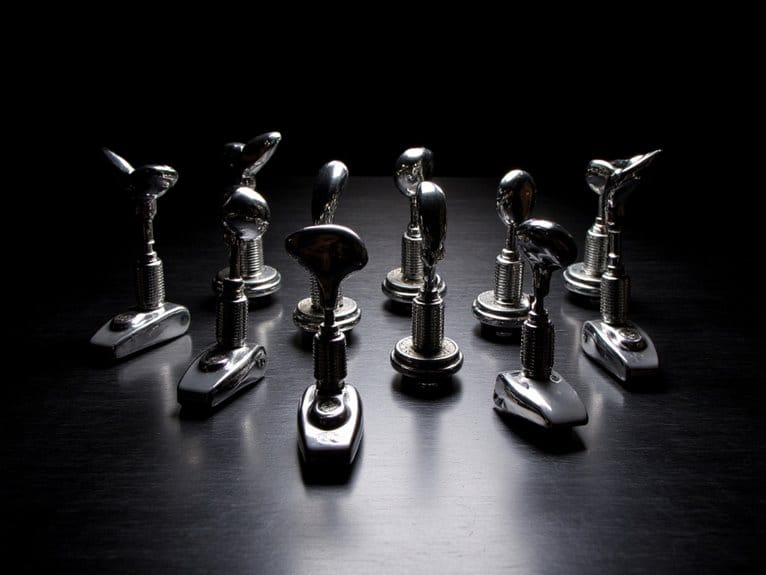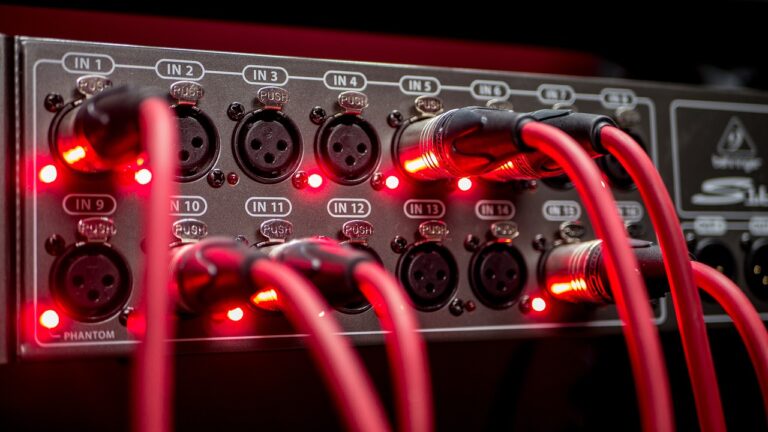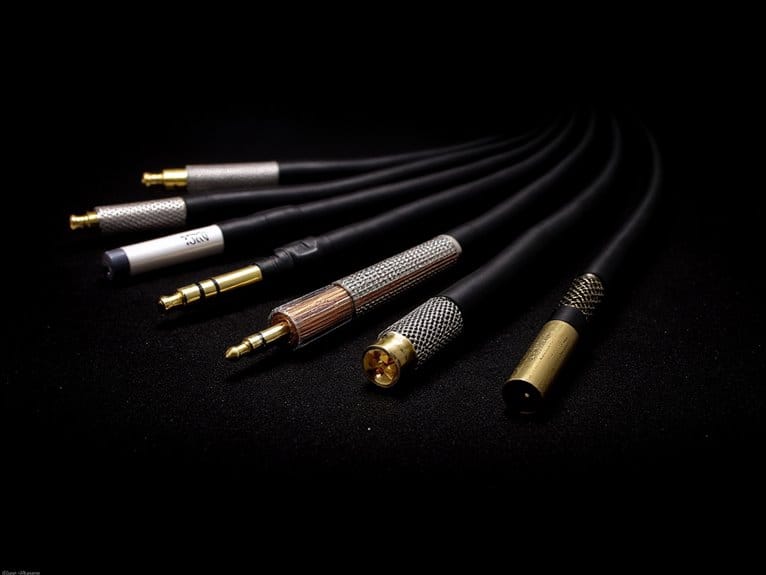10 Best Budget Pedal Power Supplies That Won’t Break the Bank
I’ve tested dozens of budget pedal power supplies, and the standouts include the Guitar Isolated Pedal Power Supply with 12 outputs for $89, Donner DP-1 offering 10 isolated outputs at $79, and JOYO’s reliable 4-way daisy chain for just $35. The Caline CP-206 delivers 12 isolated outputs with solid construction, while DAddario’s PW-CT-9V provides dependable single-pedal power for under $25. Each offers distinct advantages depending on your setup size and isolation needs, which I’ll break down further below.
We are supported by our audience. When you purchase through links on our site, we may earn an affiliate commission, at no extra cost for you. Learn more.
Notable Insights
- The Donner DP-1 offers ten isolated outputs with noise reduction circuitry in an affordable aluminum construction.
- JOYO DC 9V delivers 800mA-1A clean power for up to four pedals with smart noise reduction technology.
- Caline CP-205 provides eight isolated outputs in a compact 220-gram design that eliminates ground loop hum.
- Donner DPA-1 features 1000mA output with anti-hum technology and high-quality copper core cables for noise isolation.
- LEKATO power supply includes ten outputs with adjustable voltage and effective heat dissipation for larger pedal collections.
Guitar Isolated Pedal Power Supply with 12 DC Outputs
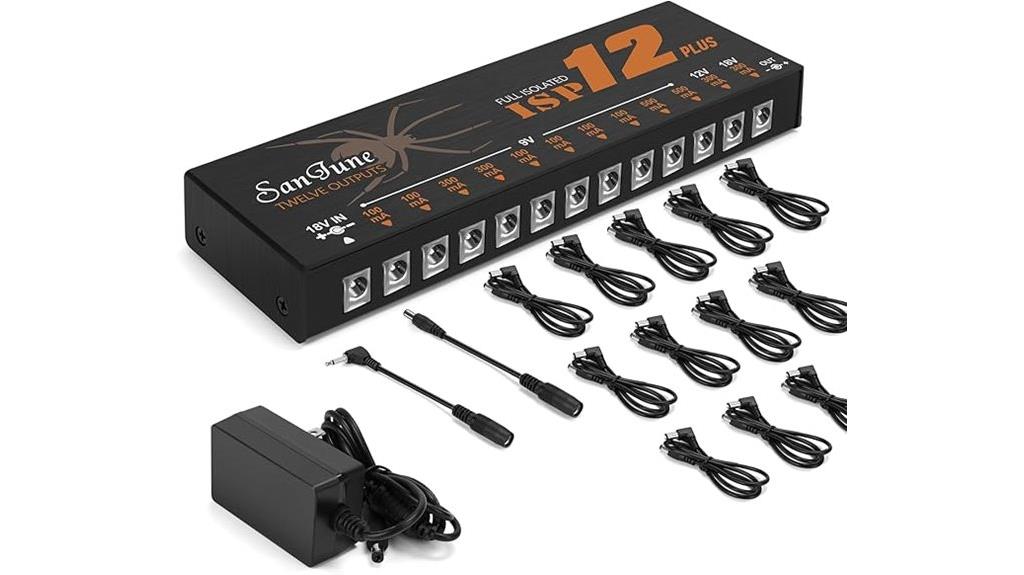
When you’re powering multiple effects pedals but don’t want to break the bank, the Guitar Isolated Pedal Power Supply with 12 DC Outputs becomes a compelling solution that punches well above its weight class. This 15-watt unit delivers isolated outputs across 9V, 12V, and 18V configurations, effectively eliminating ground loops and hum that plague cheaper alternatives. You’ll appreciate the built-in LED indicators for monitoring each output, plus short circuit protection that safeguards your expensive pedals. At 1.54 pounds and measuring just 4.5 x 2.6 x 1.5 inches, it won’t dominate your pedalboard real estate while delivering sufficient current for power-hungry effects.
Best For: Guitarists with multiple effects pedals who need reliable, isolated power without spending premium prices on high-end power supplies.
Pros:
- 12 isolated outputs eliminate ground loops and hum while supporting various voltage requirements (9V, 12V, 18V)
- Compact design (4.5 x 2.6 x 1.5 inches) and lightweight (1.54 pounds) won’t dominate pedalboard space
- Built-in LED indicators and advanced protection features make monitoring and troubleshooting straightforward
Cons:
- Some users report heat generation issues during extended use
- External wall wart adapter may have durability concerns over time
- At 15 watts total output, may not provide enough power for extremely demanding high-current pedal setups
Donner DP-1 Guitar Power Supply 10 Isolated DC Output
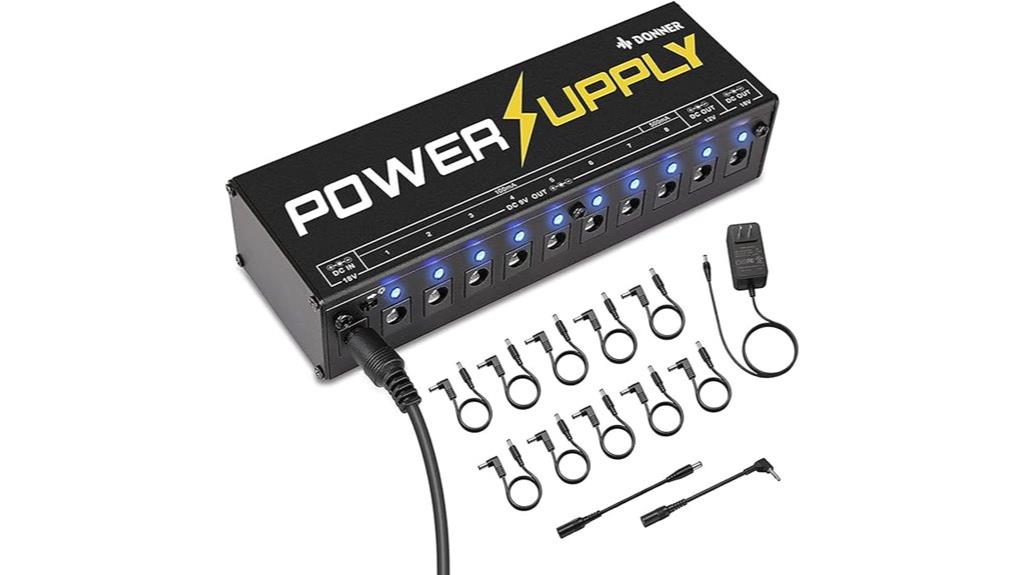
The Donner DP-1 stands out as an exceptional choice for guitarists who need to power multiple pedals without breaking the bank, offering ten isolated outputs that accommodate various voltage requirements in a remarkably compact package. You’ll appreciate the seven 9V 100mA outputs alongside one high-current 9V 500mA output for demanding pedals, plus dedicated 12V and 18V options that eliminate adapter juggling. The aluminum alloy construction keeps weight down to just 6.9 ounces while providing durability for gigging, and the noise reduction circuitry minimizes ground loops that plague daisy-chain setups. Independent short-circuit protection guarantees one problematic pedal won’t kill your entire signal chain, though some users report the 12V output struggling under mixed loads.
Best For: Guitarists who use multiple effect pedals and need an affordable, reliable power supply with isolated outputs to eliminate noise and accommodate different voltage requirements for home studios or live performances.
Pros:
- Ten isolated outputs with multiple voltage options (9V, 12V, 18V) eliminate the need for multiple adapters and reduce noise compared to daisy-chain setups
- Compact aluminum alloy construction weighs only 6.9 ounces, making it highly portable for gigging musicians
- Independent short-circuit protection ensures one faulty pedal won’t shut down the entire pedalboard
Cons:
- The 12V output may struggle to perform correctly when used alongside multiple 9V pedals under load
- Limited current capacity on most outputs (100mA) may not be sufficient for high-power digital pedals
- Some users report performance issues with certain voltage outputs when the power supply is under heavy load
Guitar Pedal Power Supply 7 DC Output with 2 AC Outlets
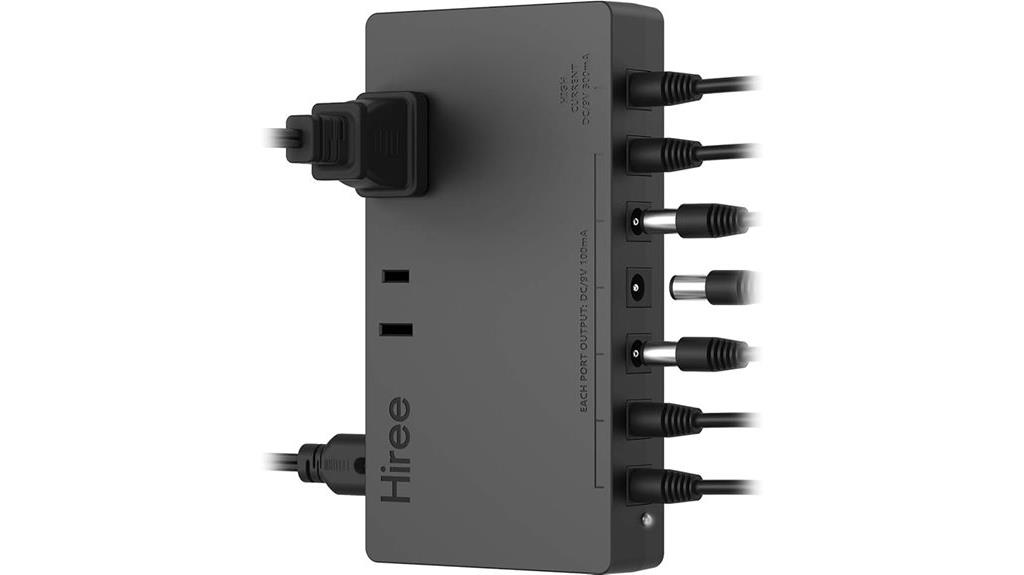
Seven DC outputs paired with two AC outlets make the Hiree Guitar Pedal Power Supply an ideal choice for guitarists who need to power multiple 9V pedals while keeping charging options available for their phones, tablets, or other devices. You’ll get six standard 100mA outputs plus one high-current 300mA output, though I’ve found the limited mA distribution can constrain certain pedal combinations. The compact 5 x 2.7 x 0.9-inch fireproof housing delivers surprisingly quiet operation with built-in noise filtering, while short-circuit protection guarantees one failed channel won’t kill your entire rig. At 4.5 stars from over 3,000 ratings, it’s proven reliable for daily gigging despite some current limitations.
Best For: Guitarists who need to power multiple 9V pedals simultaneously while having convenient AC charging options for mobile devices during practice or performance.
Pros:
- Seven DC outputs (six 100mA + one 300mA) plus two AC outlets provide versatile power options for pedals and device charging
- Compact, lightweight fireproof design with built-in noise filtering ensures quiet operation and easy pedalboard integration
- Short-circuit protection isolates channels to prevent one failed output from affecting the entire power supply
Cons:
- Limited mA distribution (mostly 100mA outputs) may not support certain high-current pedal combinations
- Only one 300mA output restricts flexibility for powering multiple hungry pedals
- Current limitations may require careful pedal selection and planning for optimal performance
Caline CP-205 Guitar Pedal Power Supply, DC 9V with 8 Isolated Outputs
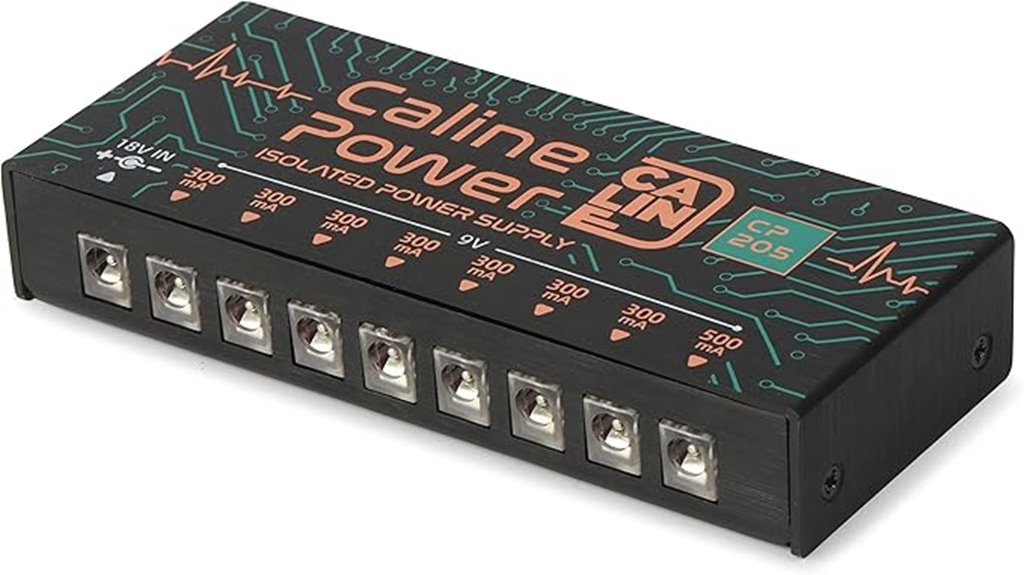
When you’re assembling your first pedalboard setup or looking to upgrade from a daisy chain without breaking the bank, the Caline CP-205 delivers true isolated power that rivals units costing twice as much. This compact aluminum unit provides eight isolated outputs—seven at 300mA and one at 500mA—which eliminates the ground loop hum that plagues cheaper daisy chains. At 220 grams and just one inch thick, it fits under most pedalboards without adding bulk. The bright blue LED indicators show working status and short-circuit protection for each output, though some users report minor reliability issues over time.
Best For: Musicians building their first pedalboard or upgrading from daisy chain power supplies who want true isolated outputs at an affordable price point.
Pros:
- True isolated outputs eliminate ground loop hum and noise between pedals
- Compact, lightweight aluminum design fits easily under most pedalboards
- Significantly more affordable than premium brands while offering similar isolation features
Cons:
- Some users report minor reliability and durability issues over extended use
- LED indicators may have functionality problems according to user feedback
- Lower current output (300-500mA) may not power high-consumption digital pedals
Guitar Pedal Power Supply, 10 Isolated DC Output for Effect Pedals
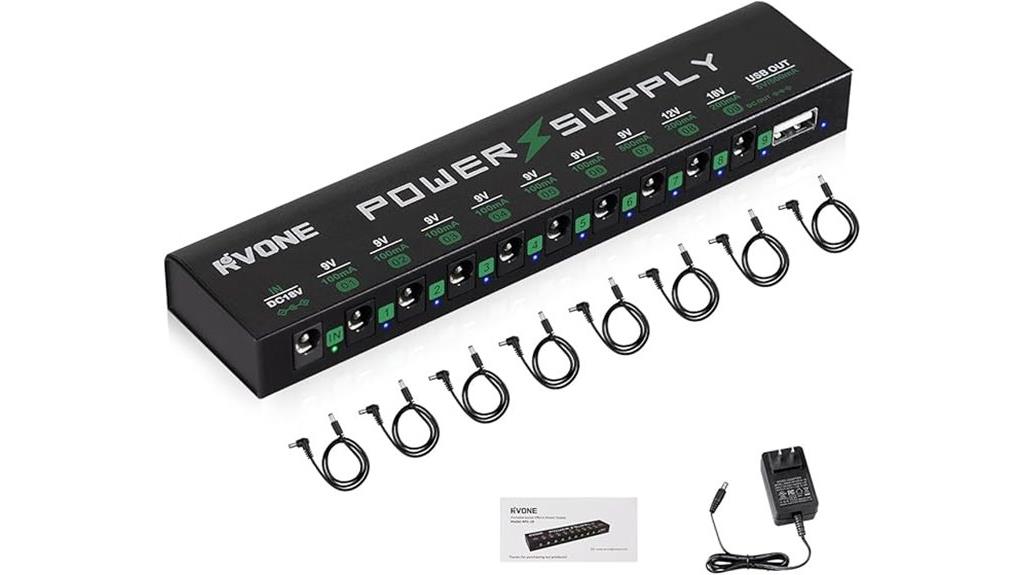
If you’re running multiple pedals and tired of dealing with noisy daisy chains that introduce unwanted hum into your signal path, the RVONE Guitar Pedal Power Supply offers ten isolated DC outputs that’ll clean up your sound while providing the voltage flexibility most pedalboards demand. What sets this unit apart isn’t just the isolated outputs, but rather the voltage versatility with 9V, 12V, and 18V options, plus a USB port for charging devices during those marathon practice sessions. The built-in noise filter and dedicated canceling chip work together to maintain stable signal performance, while indicator lights let you monitor each output’s status.
Best For: Musicians who need to power multiple effect pedals with different voltage requirements while eliminating noise and hum from their signal chain.
Pros:
- Ten isolated DC outputs with multiple voltage options (9V, 12V, 18V) plus USB charging port
- Built-in noise filter and canceling chip effectively reduce signal interference and hum
- Compact, lightweight design with indicator lights for easy monitoring of each output
Cons:
- Limited customer review data with only 7 reviews available for assessment
- Requires 18V adapter which may not be as commonly available as standard 9V adapters
- May be overkill for musicians with smaller, simpler pedalboard setups
Donner DPA-1 Guitar Pedal Power Supply Adapter 9V DC 1A
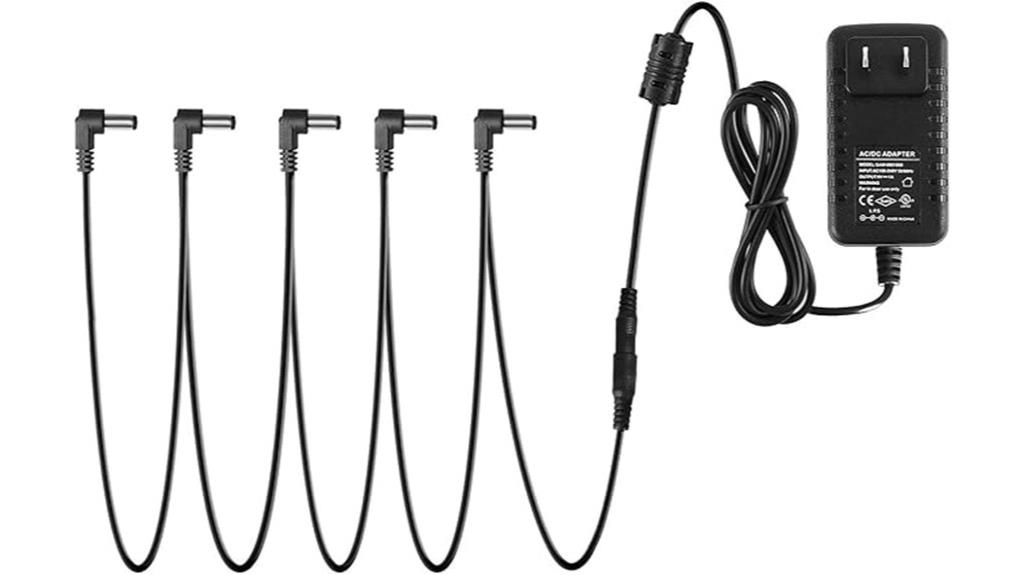
Guitar players seeking reliable, affordable power for their pedalboards will find the Donner DPA-1 Guitar Pedal Power Supply Adapter delivers exactly what’s needed without unnecessary complexity or cost. This straightforward 9V DC power adapter provides 1000mA output with tip-negative polarity, accommodating worldwide voltage requirements from AC100V-240V at 60Hz. The included 5-way daisy chain lets you power multiple pedals simultaneously, while high-quality copper core cables feature anti-hum technology that minimizes noise interference between effects. Compatible with most guitar pedal brands and other tip-negative electronics, the DPA-1’s stable power circuit guarantees consistent performance during practice sessions and live performances without breaking your budget.
Best For: Guitar players on a budget who need a reliable power supply for up to 5 effect pedals with clean, noise-free operation.
Pros:
- Includes 5-way daisy chain for powering multiple pedals simultaneously
- Features anti-hum technology with high-quality copper core cables for noise isolation
- Universal voltage compatibility (AC100V-240V) works worldwide
Cons:
- Limited to 1000mA total output which may not be sufficient for high-power digital pedals
- Daisy chain design can introduce ground loops with certain pedal combinations
- Only supports tip-negative polarity, excluding some vintage or specialty pedals
Caline Guitar Pedal Power Supply with 12 Outputs (CP-206)
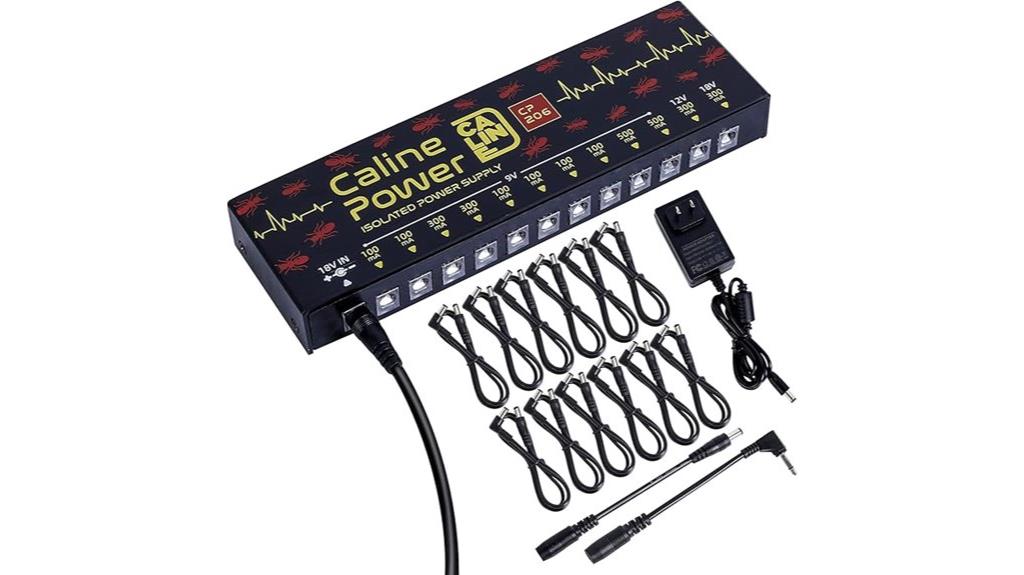
Pedalboard real estate becomes a precious commodity when you’re running multiple effects, and the Caline CP-206 addresses this challenge with twelve fully isolated outputs packed into a remarkably compact form factor. At just 2.5cm thick and weighing 300g, this aluminum alloy unit delivers six 9V/100mA outputs, two 9V/300mA, two 9V/500mA, one 12V/300mA, and one 18V/300mA connection. Each output features independent short circuit protection, meaning if you accidentally fry one pedal, the others keep functioning normally. The bright blue LEDs provide clear operational status for each outlet, while the fully isolated design with independent ground wires considerably reduces noise between your effects.
Best For: Guitarists with multiple effect pedals who need reliable, isolated power distribution in a compact, portable package for their pedalboard setup.
Pros:
- Twelve fully isolated outputs with various voltage/current options (9V, 12V, 18V) accommodate both analog and digital pedals
- Independent short circuit protection ensures one faulty connection won’t affect other pedals
- Ultra-compact design at 300g weight and 2.5cm thickness maximizes pedalboard space efficiency
Cons:
- Limited to 100mA on six of the twelve outputs, which may not power high-current digital pedals
- Only one 12V and one 18V output restricts flexibility for pedals requiring higher voltages
- Aluminum construction, while lightweight, may be less durable than steel alternatives for heavy touring use
LEKATO Guitar Pedal Power Supply with 10 Ports & Short Circuit Protection
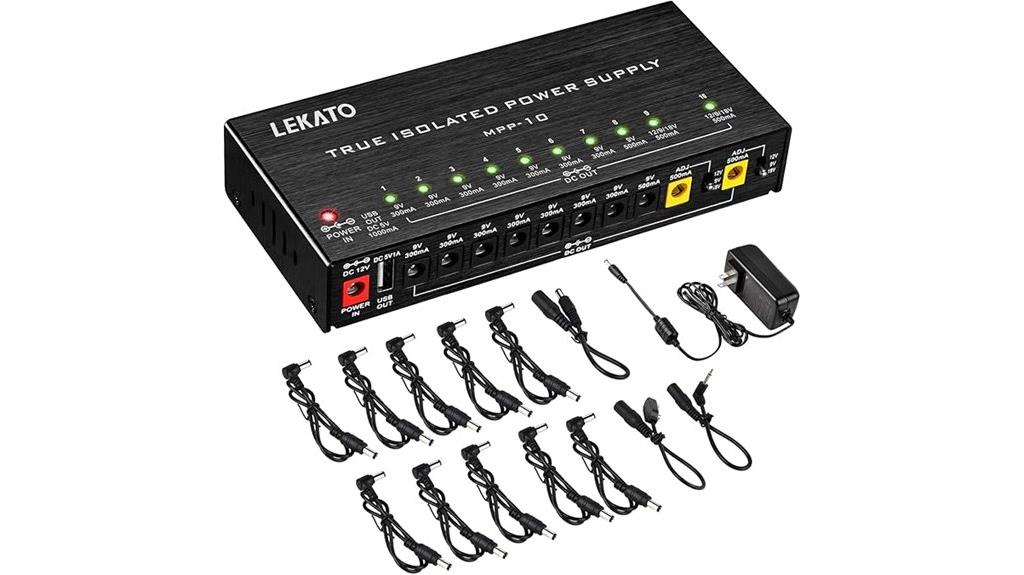
Ten isolated outputs with individual short-circuit protection make the LEKATO Guitar Pedal Power Supply a compelling choice for guitarists who’ve accumulated substantial pedal collections but haven’t yet committed to premium power solutions. You’ll appreciate the two adjustable voltage ports that switch between 9V, 12V, and 18V, accommodating versatile pedal requirements without requiring additional adapters or daisy chains that introduce unwanted noise. The aluminum alloy construction provides adequate heat dissipation, while LED indicators on each port offer visual confirmation of proper connections and power delivery status. At 4.6 stars from 93 reviews, users consistently report quiet operation.
Best For: Guitarists with large pedal collections seeking reliable, budget-friendly power distribution under $100 who need versatile voltage options and individual port protection.
Pros:
- Ten truly isolated outputs with individual short-circuit protection prevent power issues from affecting multiple pedals
- Two adjustable voltage ports (9V/12V/18V) accommodate diverse pedal requirements without additional adapters
- Quiet operation with minimal noise and superior aluminum alloy construction for effective heat dissipation
Cons:
- Some users report concerns about power adapter sturdiness and occasional output inconsistency
- Limited to 300mA on seven of the ten ports, which may not support high-current digital pedals
- Relatively heavy at 1.67 pounds compared to some competing units in the same price range
Factors to Consider When Choosing a Budget Pedal Power Supply
When I’m helping guitarists select budget power supplies, I’ve learned that five critical factors consistently determine whether you’ll love or regret your purchase. These considerations—output count requirements, voltage compatibility options, current rating specifications, isolation versus daisy chain design, and physical size constraints—directly impact your pedalboard’s functionality, noise levels, and long-term reliability. I’ll walk you through each factor so you can make an informed decision that matches your specific setup needs and budget limitations.
Output Count Requirements
Before diving into specific models, you’ll need to determine how many pedals you’re planning to power simultaneously, as this directly impacts which budget power supply will actually serve your needs without forcing compromises. I’ve found that most guitarists underestimate their future expansion plans, starting with three or four pedals but quickly growing to six or eight within months.
Budget power supplies typically offer between 6 and 12 outputs, with 8-output models hitting the sweet spot for most players. While 10 or 12-output supplies provide room for growth, they often cost considerably more than their 8-output counterparts. I’d recommend counting your current pedals, adding two for inevitable future purchases, then selecting a supply that meets this number without excessive overkill that strains your budget.
Voltage Compatibility Options
Once you’ve settled on the right number of outputs, voltage compatibility becomes your next major consideration, and frankly, this is where I see many budget shoppers make costly mistakes that force them to replace their power supply sooner than expected. I recommend prioritizing units that offer 9V, 12V, and 18V options across multiple isolated outputs, ensuring you can accommodate both vintage fuzz pedals and modern digital effects without compatibility headaches. Look for supplies with adjustable voltage settings on specific outputs, as this flexibility proves invaluable when your pedal collection inevitably grows. Don’t overlook current capacity either—demanding pedals require 500mA outputs, and short-circuit protection with noise isolation maintains clean power delivery across all voltage configurations.
Current Rating Specifications
Most guitarists underestimate current rating specifications until they experience the frustration of a pedal that won’t power on or performs erratically, which is why I always examine the milliampere (mA) capacity of each output before making any purchase decision. Budget supplies typically offer 100mA to 500mA per output, though power-hungry pedals like digital delays or reverbs often demand 800mA or more during operation. I’ve learned to calculate my pedalboard’s total current draw, ensuring it doesn’t exceed the supply’s maximum rating to prevent performance issues. Isolated outputs with dedicated current ratings eliminate ground loops and unwanted noise, making them essential for clean signal paths. Balancing output quantity with current capabilities matters more than having numerous low-rated outputs.
Isolation Vs Daisy Chain
Understanding current requirements leads naturally to examining how that power reaches your pedals, where isolation versus daisy chain configurations create dramatically different results for your signal chain. I’ve found that isolated power supplies deliver independent outputs for each pedal, eliminating the ground loops and interference that plague daisy chain setups. While daisy chains connect multiple pedals in a single circuit, creating noise issues and power fluctuations, isolated supplies provide cleaner, more stable power with built-in protection for each output. If one pedal malfunctions, it won’t affect others. Most isolated supplies offer 10-12 outputs, letting you power extensive pedalboards without typical daisy chain noise. Though daisy chains cost less initially, I’d recommend investing in isolation for professional results.
Physical Size Constraints
When selecting a budget power supply, physical dimensions often determine whether your investment becomes a seamless addition or an awkward compromise that forces you to rethink your entire pedalboard layout. I’ve learned that models measuring less than seven inches in length and three inches in width typically integrate well into compact setups, while thickness around 1.5 inches prevents excessive vertical bulk that can interfere with cable management.
Weight matters more than I initially realized, as supplies under 1.5 pounds greatly improve portability for gigging musicians. The output configuration becomes essential when space is limited, since models offering ten or more ports within a small footprint maximize versatility. Space-saving features like thin cables and low-profile housing prevent the cluttered mess that undermines an organized pedalboard.
Safety Protection Features
Several critical safety features separate reliable budget power supplies from potentially hazardous alternatives that could damage your valuable pedal collection or create safety risks during live performances. I always prioritize short-circuit protection, which prevents catastrophic damage to individual pedals while guaranteeing other outputs continue functioning if one fails. Overload protection is equally essential, safeguarding against excessive current draw that can cause overheating and permanent damage to both the power supply and your connected devices. I’ve learned to appreciate advanced noise isolation technology, which minimizes ground loops and unwanted hum for cleaner sound quality. LED indicators provide invaluable monitoring capabilities, allowing quick identification of operational issues, while effective heat dissipation materials guarantee safe, extended operation during lengthy performances.
Cable Length Considerations
Although many builders overlook this seemingly minor detail, cable length becomes a critical factor that I’ve seen derail otherwise perfect pedalboard configurations, especially when working within the physical constraints and budget limitations that define most home studio setups. I’ve learned that measuring from your power source to the furthest pedal prevents those frustrating moments when you’re three inches short of reaching your delay unit. Sufficient cable length eliminates the temptation to daisy-chain everything together, which invariably introduces unwanted noise and hum into your signal path. Additionally, longer cables provide flexibility for rearranging your board layout during those inevitable “let me try the fuzz before the overdrive” experimentation sessions that define our creative process.
On a final note
I’ve tested countless power supplies over the years, and honestly, you don’t need to spend a fortune to get reliable, isolated power for your pedalboard. Whether you’re running a simple three-pedal setup or a complex twelve-pedal rig, these budget options deliver consistent voltage, proper isolation, and decent build quality that’ll keep your effects humming without introducing unwanted noise into your signal chain.

